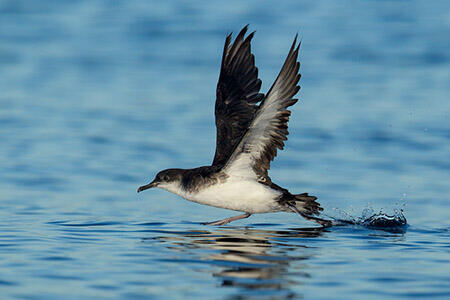- Scientific name: Puffinus puffinus
Species of Greatest Conservation Need (MA State Wildlife Action Plan)
Description

Manx shearwater (Puffinus puffinus)
Manx shearwaters are blackish above with a dark face, white below, and have white wing linings. They are a medium sized seabird: 30–38 cm (12-15 in) long with a 76–89 cm (30-35 in) wingspan and a mass of around 400 g (14 oz). They have a long, slender, dark bill that is hooked at the end. Manx shearwaters are in the order Procellariiformes and have nasal tubes that assist in salt removal.
Life cycle and behavior
Manx shearwaters are nocturnal, burrow nesting seabirds. They have a protracted breeding season, especially in comparison to other shearwaters. Individuals begin congregating near breeding colonies beginning in February. They return to the colony at night intermittently at first, likely spending the pre-breeding period increasing fat reserves. Both adults excavate or repair burrows with their bills and feet. North American populations tend to occupy rock crevices first, with burrow occupancy increasing as preferred habitat declines. Egg laying is somewhat asynchronous, with first eggs laid varying across colonies. Pairs lay one egg per season. Both sexes share incubation duties, but the female departs for about six days immediately after the egg is laid. The incubation period ranges from 47–66 days. Chicks are downy when hatched and gain more mobility after the first week. Both parents provision chicks, regurgitating partially digested food. Chicks fledge at around 69 days. Fledglings will sit at the edge of the burrow for several nights prior to fledge and exercise their wings. Fledglings leave at night and either launch themselves from cliffs or rocky outcrops or walk across the colony. Age at first breeding is usually five to six years old. Maximum life span estimates are variable, but one individual reached 52 years old.
Schooling fish are a major diet component, particularly herring, sardines, and anchovies. They also take cephalopods, crustaceans, and fishing offal. They capture prey from the water surface and can dive to an average depth of 31 m (~100 ft).
Population status
The global Manx shearwater population estimate is 680,000–790,000 mature individuals. Manx shearwater densities in North American marine habitats are very low.
Distribution and abundance
Manx shearwaters are the northernmost breeding shearwater species and are distributed throughout the north Atlantic. European breeding colonies include Iceland, the Faroe Islands, the United Kingdom, Ireland, France, the Azores and the Canary Islands.
Breeding colonies in North America are likely expansions from European populations. These colonies include a stable population on Middle Lawn Island in Newfoundland, a few individuals nesting on islands in the Gulf of Maine, and suspected breeding individuals near Revere Beach, Massachusetts, in Long Island Sound, New York, and in Rhode Island. There are historical records from 1973 of Manx shearwaters breeding on Penikese Island.
Nonbreeding Manx shearwaters are found throughout the north and south Atlantic.
Habitat
Breeding habitats are mostly remote, uninhabited islands and headlands with few mammalian predators. The habitat is usually open with minimal trees and with suitable soil for burrow nesting.
Marine habitats vary widely but individuals are typically found on continental shelves. Healthy habitats are vital for supporting native wildlife and plants. Explore habitats and learn about conservation and restoration in Massachusetts.
Threats
Major threats to Manx shearwaters are introduced predators, mainly cats and rats, bycatch, harvesting, oil spills, and collisions due to light attraction. Predation pressure from natural predators, such as great skuas, herring gulls, common ravens, and golden eagles, can be substantial as well. Habitat degradation from overgrazing reduces nesting habitat. Plastic ingestion is also a concern. Plastic trash in the environment poses a threat as it can be mistaken as food by seabirds and shorebirds and ingested or cause entanglement. Ingested plastics, common for seabirds, can block digestive tracts, cause internal injuries, disrupt the endocrine system, and lead to death. Entanglement from fishing gear and other string-like plastics can cause mortality by strangulation and impairing movements.
Conservation
Conservation actions specific to Manx shearwaters are limited. Artificial light attraction has been curtailed through colored lights or structural shielding. Translocation of shearwater chicks to other Great Britain nesting colonies has been attempted and artificial burrows on Newfoundland are used to increase available nesting habitat. Manx shearwaters benefit from habitat official designations and protection, as this controls potential influxes of mammalian invasive species and predators.
Future research priorities include diet studies, at-sea biology, genetic and molecular comparisons, and further studies focused specifically on North American breeding individuals.
Avoid or recycle single-use plastics and promote and participate in beach cleanup efforts.
References
BirdLife International. Species factsheet: Manx shearwater Puffinus puffinus. 2018. https://datazone.birdlife.org/species/factsheet/manx-shearwater-puffinus-puffinus
Enticott, J., and D. Tipling. Seabirds of the World. Mechanicsburg, PA: Stackpole Books, 1997.
Lee, D. S., J. C. Haney, C. Carboneras, F. Jutglar, and G. M. Kirwan. Manx shearwater (Puffinus puffinus), version 1.1. In Birds of the World (N. D. Sly, Editor). Cornell Lab of Ornithology, Ithaca, NY, USA, 2023. https://doi-org.silk.library.umass.edu/10.2173/bow.manshe.01.1
Paleczny, M., E. Hammill, V. Karpouzi, and D. Pauly. “Population Trend of the World's Monitored Seabirds, 1950-2010.” PLoS ONE 10, no. 6 (2015).
Veit, R., and W.R. Petersen. Birds of Massachusetts. Lincoln, MA: Massachusetts Audubon Society, 1993.
Contact
| Date published: | May 15, 2025 |
|---|